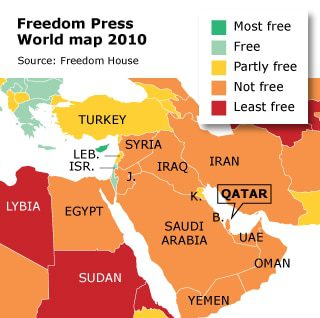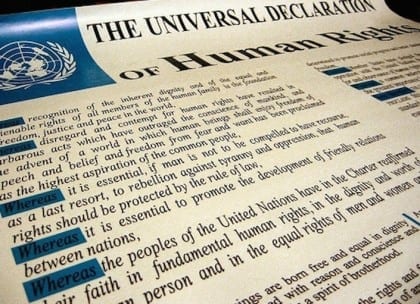
Introduction
The concept of human rights has become a well-known and widely accepted term to use. Varying interpretations are possible, with differences usually being based on cultural background. Nonetheless, most of these understandings consciously or subconsciously include the basic rights outlined in the United Nations’ Universal Declaration of Human Rights.
The United Nations General Assembly (GA) adopted the Universal Declaration of Human Rights on December 10th, 1948. It was written in the aftermath of World War II, “… as a common standard of achievement for all peoples and all nations, to the end that every individual and every organ of society, keeping this Declaration constantly in mind…” Thus it was truly meant to be universal, to protect citizens from any type of violation the world had recently experienced, as outlined in the Preamble and 30 Articles.
As such, it includes articles on the right to life in dignity; liberty and security; freedom of movement; right to nationality and education; just treatment of human beings and respect; as well as freedom of expressions and opinions, from torture or inhumane treatment, as well as economic, social and cultural rights.
International Human Rights Law
The Declaration is not legally binding, but is the basis of international human rights law. Two binding UN covenants were formed as a result of the UDHR; the International Covenant on Civil and Political Rights and the International Covenant on Economic, Social and Cultural Rights. Combined, these three documents are often referred to as the “International Bill of Human Rights”.
Over the years other conventions have been written to expand on and add to this fundament, focusing on a variety of topics such as refugees (1951 and 1967), discrimination of women (‘CEDAW’, 1979) and disabled persons (2008), against torture (1987), protection of migrant workers (1990), and against racial discrimination (1969) to name a few.
Additionally, the International Labour Organization has compiled a large number of conventions specifically related to work force and labour standards, of which 8 are considered ‘fundamental conventions’ and relate to freedom of association (1948, C087), collective bargaining (1949, C098), forced labour (1930, C029 and 1957, C105), minimum age (1973, C138), child labour (1999, C182), equal remuneration (1951, C100), equal opportunity and treatment (C111).
Geneva Conventions
The Geneva Conventions are a revision of previously constructed conventions, adjusted after WWII and specifically focus on treatment of persons in time of war. It consists of four Conventions, and three additional protocols. The International Committee of the Red Cross (ICRC) explains that the Conventions “aims at ensuring that, even in the midst of hostilities, the dignity of the human person, universally acknowledged in principle, shall be respected.”
During a series of expert meetings, congregations by Red Cross agencies, and a confluence of government representatives over time, the articles were revised until a draft was represented at The Diplomatic Conference for the Establishment of International Conventions for the Protection of Victims of War in 1949. The Final Act was signed by fifty-nine nations, some of which no longer exist, and has attained more signatories since.
The Cairo Declaration on Human Rights in Islam (CDHRI) was compiled by the Organisation of Islamic Cooperation (OIC) in 1990, during the 19th Islamic Conference of Foreign Ministers in Cairo, and has 57 signatories. This Declaration holds similar – if not identical – principles as the UDHR, but notably also included articles related to ‘jus in bello’ – acceptable wartime conduct, alike the Geneva Conventions. The CDHRI also addresses equality between women and men, rights of the child, freedom, right to medical care, right to self-determination, amongst others. Most notably is that this 25 Article document clearly lists the Sharia as reference point including for punishment. The CDHRI has been adopted by 45 countries, out of the total 57 members of the OIC.
Refugees
The Convention relating to the Status of Refugees is based off Article 14 of the UDHR, and recognizes the right of asylum and protection of refugees. It was approved during the General Assembly meeting of December 14, 1950 and came into force on April 22, 1954. However, the original Convention limited its scope to refugees fleeing prior to 1 January 1951. As such, an additional protocol was compiled in 1967, removing these limitations.
Qatar is not party to the 1951 Convention, nor its Protocol.
Women
The Convention on the Elimination of All Forms of Discrimination against Women – also called CEDAW, was approved during the General Assembly Session on 18 December, 1979 and entered into force on 3 September 1981. Qatar acceded to the Convention on April 29, 2009. Through “accession” a state accepts the offer or the opportunity to become a party to a treaty, which has already negotiated and signed by other states. It has the same legal effect as ratification. Countries that have ratified or acceded CEDAW are legally bound to put its provisions into practice, and thereby agree to submit national reports on measures taken to comply with its obligations. Such reports are to be compiled at least every four years.
Qatar made some reservations, however, regarding a number of articles, mostly due to incompatibility with existent national laws or the constitution. This is the case for Article 2 (a), related to equality of men and women in the constitution; Article 9 (2), concerning children’s nationality – inconsistent with Qatari citizenship law; Article 15 paragraph 1, prescribing equality before the law – contradicts Sharia, and 4, concerning equality of freedom of movement; Article 16 (1a), prescribing the same right to enter into marriage; (1c), granting equal rights during marriage and its dissolution; (1f), listing equal rights and responsibilities with regard to guardianship, wardship, trusteeship, and adoption of children.
Additionally, it does not consider itself bound by Article 29 (1), discussing dispute between states concerning interpretation or application of the Convention. It is noteworthy that Article 29 (2) specifically allows for such a reservation. Moreover Qatar made declarations insisting agreement with Article 1 (defining the term ‘discrimination of women’) does not mean it encourages extra-marital relationships, and that the ‘patterns’ mentioned in Article 5 (a), prescribing modification of social and cultural patterns, should not be understood as encouraging women to abandon their mothering roles.
Persons with Disabilities
The Convention on the Rights of Persons with Disabilities was approved during the General Assembly session on December 13, 2006 and came into force on May 3, 2008. Simultaneously, the Optional Protocol was approved, giving the Committee on the Rights of Persons with Disabilities (CRPD) competence to examine individual complaints with regard to alleged violations by States parties to the Protocol. The CRPD is the body of independent experts that monitors implementation of the Convention. Qatar signed the Optional Protocol alongside the Convention on July 9, 2007 and ratified the latter on May 13, 2008 without any reservations.
Torture
The Convention against Torture and Other Cruel, Inhuman, or Degrading Treatment or Punishment, also referred to as just the Convention against Torture, was adopted during the General Assembly session on December 10, 1984. On June 26, 1987 it was registered and thereby came into force. Its implementation is monitored by the Committee Against Torture(CAT), composed of ten individuals of various nationalities. All signatory states are obliged to send regular reports to the CAT, based on which recommendations are made.
Qatar accessed to the Convention on January 11, 2000. It holds a ‘limited general reservation’ within the framework of Articles 1, defining the concept of torture; and 16 relating to the prevention of cruel, inhuman or degrading treatment not considered torture. Additionally, Qatar agrees to the mandate of the Committee as stipulated in Articles 21 and 22, to which it had previously made a reservation.
Migrant Workers
The International Convention on the Protection of the Rights of All Migrant Workers and Members of their Families was approved by the General Assembly on December 18, 1990 and entered into force on July 1, 2003. Qatar is not party to the Convention.
Racial Discrimination
The Convention on the Elimination of All Forms of Racial Discrimination was approved by the General Assembly and accordingly opened for signature on March 7, 1966. It entered into force on January 4, 1969. Despite the obvious as stated in the Convention title, it aims to obliterate hate speech and promote understanding. Implementation of the articles is monitored by the Committee on the Elimination of Racial Discrimination, to which bi-annual reports are submitted by each signatory. It also is responsible for handling inter-state and individual complaints related to non-conformity to the provisions of the Convention, as prescribed in Article 14.
Qatar acceded to the Convention on July 22, 1976 with no reservations.
Human Rights in Qatar
Visitors returning to Qatar after only a few years of absence, invariably remark on the changes the country has experienced in such a short period. But behind the brash facades of modernist architecture, the air-conditioned shopping malls, and the confident attitude of Qatar’s cosmopolitan and well-educated youth, lie the sobering realities of a politically restrictive police state. Qatar’s police, military and internal security services continue to be controlled by the Emir.
In addition to the General Intelligence Agency and the State Intelligence Security Unit, headed by powerful members of the royal family, the Emir created the State Security Agency in 2003 and an Internal Security Force in 2006. The Emir’s son, Crown prince Tamim bin Hamad, heads the Qatar Security Services Company, which is said to rely on foreign private security firms like those supplementing the Western occupation forces in Iraq.
Qatar has signed the UN Convention against Torture and Other Cruel, Inhuman, and Degrading Treatment or Punishment. Article 36 of the Constitution states that no one shall be subjected ‘to torture or humiliating treatment. Torture is a crime and shall be punished by the law’. Nevertheless, in 2008 the US Department of State assessed that ‘there were allegations that police investigators regularly abused incarcerated suspects during interrogations to elicit confessions’. However, documentation on the issue was very limited, ‘due partly to hesitancy by alleged victims to make claims of torture or abuse’. (For its most recent report, see 2009 Human Rights Report: Qatar)
In 2006, the UN Committee against Torture criticized Qatar for ‘the lack of a comprehensive definition of torture in domestic law and the absence of training and education for law enforcement, medical personnel, and public officials about the prohibition [of torture]’.
A local government funded National Human Rights Committee (NHRC) was created in 2002 by decree of the Emir. In 2005 it published its first Annual Report. According to this document, Qatar’s prisons and detention centres were ‘deficient in terms of parole, medical release, overcrowding and food’. Although the Constitution explicitly prohibits arbitrary arrests and detention, thousands of non-citizens were held at the Deportation Detention Centre without any charge or trial – sometimes for more than three years – before being expelled. Gulf Cooperation Council (GCC) citizens are held separately from non-GCC detainees and under better conditions.
Press Freedom

The new Constitution provides for freedom of the press. In 1995, the Ministry of Information was abolished by the new Emir with the aim of ‘providing more chances for the freedom of expression’. However, its supervisory tasks have slowly been transferred to other ministries and a number of new government organizations. Most prominent among these is the Qatar General Broadcasting and Television Corporation and its administrative unit, the Department of Publications.
Together, these two organizations strictly control and regulate the domestic media, both audio-visual and print. However, they control more than just the press: one of the tasks of the Department of Publications is to ensure that all – national or foreign – publications and ‘artistic productions’ comply with what the government considers to be ‘culturally appropriate content’.
In addition to the censorship the state continues to exert through the abovementioned organizations, security authorities have warned individuals and organizations against publishing certain articles. Moreover, the 1979 Press and Publications Law provides for criminal penalties and jail sentences for libel and slander, including injury to dignity.
Taking all these direct and indirect forms of media state control into consideration, it should come as no surprise that self-censorship is standard practice among local journalists. Even the Internet has not been able to develop into a less restricted local platform for expression. The country has only one Internet provider. It is state-owned and monitors – and if deemed necessary blocks – websites, email services and chat rooms.
According to Freedom House’s Map of Press Freedom 2010, the status of Qatar and most other countries in the region is ‘not free’.
Latest Articles
Below are the latest articles by acclaimed journalists and academics concerning the topic ‘Human Rights’ and ‘Qatar’. These articles are posted in this country file or elsewhere on our website:













